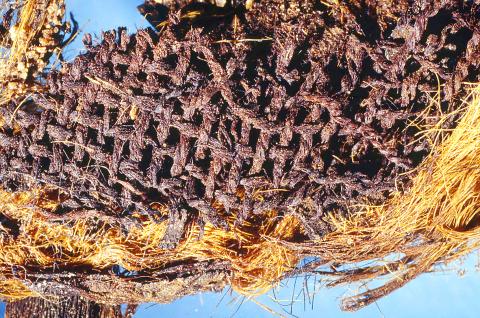It has long been known that the practice of mummification of the dead in ancient Egypt was old, but researchers are now uncovering just how long ago it began.
Researchers on Wednesday said a form of mummification was being carried out more than 6,000 years ago, much earlier than previously thought. Embalming substances contained in funerary textiles from the oldest-known Egyptian cemeteries showed mummy-making from as early as about 4300 BC, they said.
The embalming agents were infused into the linen used to wrap the corpse to provide an antibacterial and protective barrier. Their use was not as elaborate as the process used much later, but came more than 1,500 years earlier than Egyptian mummification had been thought to have started.

Photo: Reuters
There is evidence of mummification from about 2600 BC and evidence of linen that contained resin being used to wrap bodies around 2800 BC, but researchers were amazed to find that the plant, animal and mineral components used in preparing the mummies at the cemeteries in Mostagedda in central Egypt were essentially the same embalming “recipe” used thousands of years later.
“I was surprised that the prehistoric Egyptians, who lived in a tribal society 1,000 years before the invention of writing, were already in possession of the empirical science that would later become true mummification,” said researcher Jana Jones, an Egyptologist at Macquarie University in Australia.
Biochemical analysis identified the components from funerary textiles retrieved from the cemeteries during excavations in the 1920s and 1930s and held in Britain’s Bolton Museum. The study appears in the scientific journal PLOS ONE.

Malaysia yesterday installed a motorcycle-riding billionaire sultan as its new king in lavish ceremonies for a post seen as a ballast in times of political crises. The coronation ceremony for Malaysia’s King Sultan Ibrahim, 65, at the National Palace in Kuala Lumpur followed his oath-taking in January as the country’s 17th monarch. Malaysia is a constitutional monarchy, with a unique arrangement that sees the throne change hands every five years between the rulers of nine Malaysian states headed by centuries-old Islamic royalty. While chiefly ceremonial, the position of king has in the past few years played an increasingly important role. Royal intervention was

X-37B COMPARISON: China’s spaceplane is most likely testing technology, much like US’ vehicle, said Victoria Samson, an official at the Secure World Foundation China’s shadowy, uncrewed reusable spacecraft, which launches atop a rocket booster and lands at a secretive military airfield, is most likely testing technology, but could also be used for manipulating or retrieving satellites, experts said. The spacecraft, on its third mission, was last month observed releasing an object, moving several kilometers away and then maneuvering back to within a few hundred meters of it. “It’s obvious that it has a military application, including, for example, closely inspecting objects of the enemy or disabling them, but it also has non-military applications,” said Marco Langbroek, a lecturer in optical space situational awareness at Delft

The Philippine Air Force must ramp up pilot training if it is to buy 20 or more multirole fighter jets as it modernizes and expands joint operations with its navy, a commander said yesterday. A day earlier US National Security Adviser Jake Sullivan said that the US “will do what is necessary” to see that the Philippines is able to resupply a ship on the Second Thomas Shoal (Renai Shoal, 仁愛暗沙) that Manila uses to reinforce its claims to the atoll. Sullivan said the US would prefer that the Philippines conducts the resupplies of the small crew on the warship Sierra Madre,

AIRLINES RECOVERING: Two-thirds of the flights canceled on Saturday due to the faulty CrowdStrike update that hit 8.5 million devices worldwide occurred in the US As the world continues to recover from massive business and travel disruptions caused by a faulty software update from cybersecurity firm CrowdStrike, malicious actors are trying to exploit the situation for their own gain. Government cybersecurity agencies across the globe and CrowdStrike CEO George Kurtz are warning businesses and individuals around the world about new phishing schemes that involve malicious actors posing as CrowdStrike employees or other tech specialists offering to assist those recovering from the outage. “We know that adversaries and bad actors will try to exploit events like this,” Kurtz said in a statement. “I encourage everyone to remain vigilant